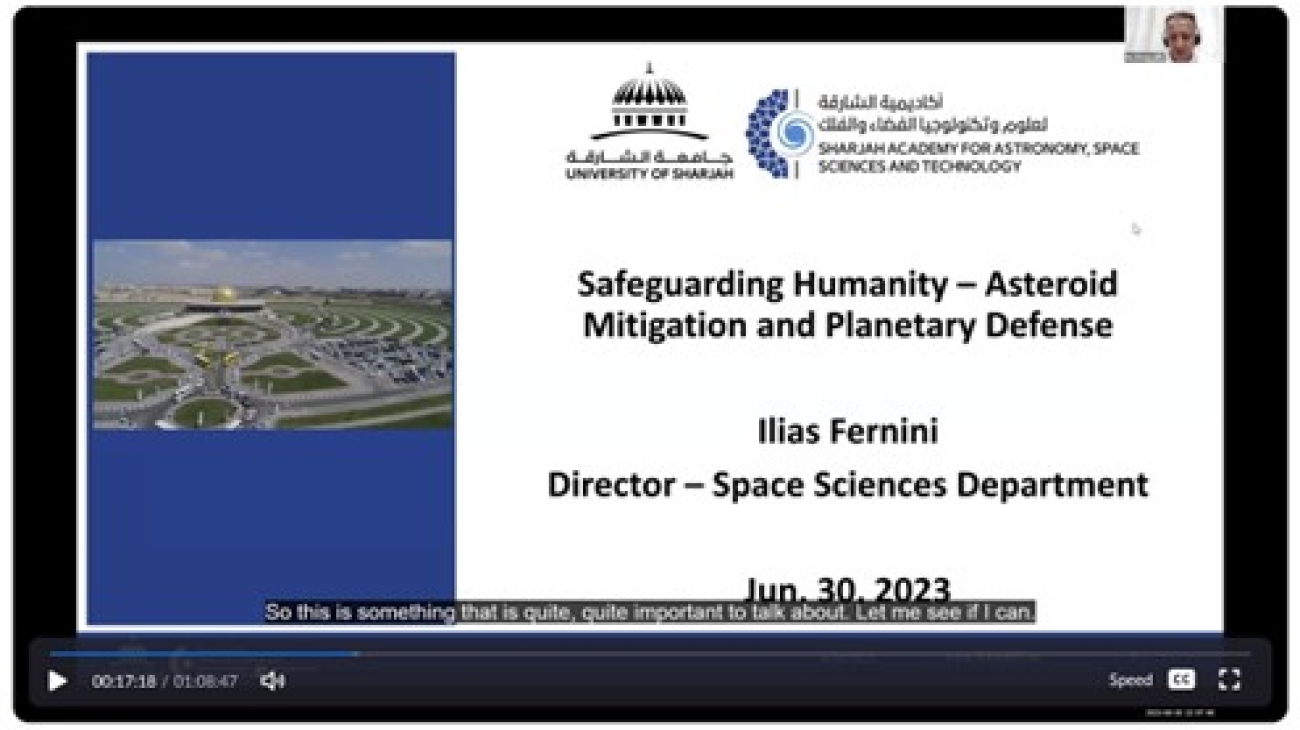Prof. Ilias Fernini, SAASST Director of the Space Sciences Department, gave the lecture.
Mitigating the potential impact of an asteroid is a complex and multi-faceted challenge that requires a combination of early detection, accurate tracking, and strategic planning. While the likelihood of a catastrophic asteroid collision with Earth is low, the potential consequences demand proactive measures to minimize the impact and protect human life. Here is a comprehensive summary of the key mitigations for an asteroid impact:
- Early Detection and Tracking:
- Establishing a global network of observatories and space-based telescopes to promptly identify and track near-Earth objects (NEOs).
- Strengthening collaborations between space agencies, governments, and international organizations to share data and coordinate efforts.
- Investing in advanced technology, such as next-generation telescopes and improved data analysis techniques, to enhance detection capabilities.
- Characterization and Assessment:
- Conducting detailed surveys of potentially hazardous asteroids to determine their size, composition, shape, and rotational characteristics.
- Utilizing radar and spectroscopic observations to gather essential data about asteroids' physical properties and potential impact scenarios.
- Prioritizing the study of objects that pose a higher risk to Earth and refining impact probability calculations.
- Deflection Techniques:
- Non-nuclear options: Developing and testing non-explosive methods for altering the trajectory of an asteroid, such as the kinetic impactor technique. This involves deliberately crashing a spacecraft into the asteroid to change its orbit.
- Nuclear options: Assessing the feasibility and potential effectiveness of nuclear detonations near an approaching asteroid to disrupt or alter its course.
- Gravity tractors: Evaluating the use of spacecraft positioned near an asteroid to alter its trajectory through gravitational interaction gradually.
- Solar sails: Investigating the possibility of deploying large reflective sails on an asteroid's surface to utilize the pressure of sunlight and modify its orbit over time.
- Evacuation and Sheltering:
- Establishing clear protocols and evacuation plans to relocate populations in potential impact zones.
- Designing and constructing underground or reinforced shelters capable of withstanding the blast, heat, and shockwaves generated by an asteroid impact.
- Educating the public about emergency procedures, including evacuation routes, communication channels, and post-impact survival strategies.
- International Cooperation:
- Fostering global collaboration and coordination through organizations such as the United Nations Office for Outer Space Affairs (UNOOSA) and the International Asteroid Warning Network (IAWN).
- Encouraging the sharing of resources, data, and expertise among countries to pool efforts and capabilities for early detection, tracking, and mitigation.
- Establishing an international decision-making and response coordination framework during a potential asteroid impact scenario.
- Public Awareness and Education:
- Promoting public awareness campaigns to inform and educate people about the nature of asteroids, their potential risks, and ongoing mitigation efforts.
- Engaging with the media, educational institutions, and scientific organizations to disseminate accurate and reliable information about asteroid impacts and mitigation strategies.
- Encouraging citizen science initiatives to involve the public in asteroid monitoring, tracking, and analysis efforts.
- Continual Research and Development:
- Allocating resources for ongoing research and development of asteroid mitigation technologies, including propulsion systems, impact modeling, and improved monitoring techniques.
- Encouraging interdisciplinary collaborations between scientists, engineers, and experts from various fields to advance our understanding of asteroids and develop innovative mitigation approaches.
It is worth noting that while significant progress has been made in asteroid detection and tracking, some of the deflection techniques mentioned above are still in the experimental stage. Continued research, international cooperation, and investments in advanced technologies are crucial for enhancing our ability to mitigate the impact of potential asteroid threats in the future.



